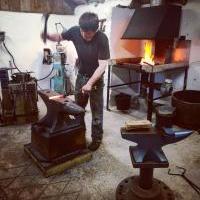-
Posts
2,024 -
Joined
-
Last visited
Profile Information
-
Gender
Male
-
Location
Sydney Australia
-
Interests
Building, Metalwork
Recent Profile Visitors
6,686 profile views
-
A lot of cheaper anvils turn out to be decent for most work a hobby blacksmith produces. Any ASO is, in my opinion, better than a piece of. rail. There is always too much emphasis placed on the anvil from beginners, at the detriment of all the other tools that are required. Anvil is just a tool, and to be used for what it was made, beat hot iron on it. All anvils deteriorate and suffer from work done on them, the only difference is the rate at which they do so. You can damage the best and most expensive anvil if you are really determined. A cheaper anvil will require a bit more care but will be a useful tool until you find a better and bigger one. 100 pounds is a small anvil for small work with small hammers. Use it and learn with it. Take a before and after photo, after one year and two and three years of work. That is the only way to tell an anvil quality or lack of it. An anvil with 95% rebound may end up chipping, and anvil with 50% rebound may turn out to be a real workhorse for 5 years, when you will invariably buy a bigger and better one. And it beats a piece of rail, hands down and blindfolded, on the side or standing up.
-
Never understood the need to mimic a tree stump by joining lumber together. Make a tripod with heavy RHS or angle or H beam or anything else in steel and you have a good stand. Make a box out of heavy plate and fill wtih sand, and you have a nice silent stand. But laminated?
-
The Covid vaccine will go down in history as the biggest potential business ever, with the possibility of it being made compulsory in many countries. Development paid by taxpayer and then billions in profits for private enterprise. With this carrot dangling in front, the donkeys are cutting corners like never before. Ethics gone out the door, protocol non existent. In a nutshell, what makes this vaccine difficult is the fact that no one was able to isolate the virus. A vaccine is based on the idea of inoculating the patogen, so that the person can develop antibodies against it, but without the nasty effects of the illness. To achieve this, the patogen, be it virus or bacteria is attenuated, so that it loses the potential for development but gives the organism the chance to recognise it and fight it when it is the real thing. Basically it is about giving the body some training using blanks. But what happens if you can not isolate the virus? You can not attenuate it and so you can not make a vaccine. Simple. What they have done in Oxford is to break down the virus and take parts of it's RNA and reproduce it in a synthetic form. The body will recognise this synthetic form and then act against the real thing, or so they hope. There is a catch though. This synthetic virus made of a simulated RNA will become part of the DNA of the person with unknown consequences. No one knows what it will alter and to what degree. It is the shonkiest and most rushed and botched "vaccine" humanity has ever seen. When asked, many well known professors in immunology if they would have the vaccine themselves, they all said no. Here is a bit of a chat about some vaccines, but written mainly with data from AstraZeneca who has the most to gain, and WHO that ... basically xxx x xxxxx xx xxxxxxxx xxxxxxx xxxxxxx. https://www.statnews.com/2020/07/20/...of%20patients.
-
If the cuts are from cutting disk and not chisel, they are likely to bother you less as you work on the anvil. The one that get hammered the most will also close up some. All in all it is likely to be more an aesthetic issue than a real one. Use it as it is for a while and see how you go. By the way ,what can you make?
-
Very true. A chisel makes a lot of damage but does not remove steel. Grinding the lips of the cut is a sure way to never get that back. Anyway, what is done is done. Just working on it will improve that surface. I remember a dodgy anvil we had in the shop years ago, that was given to the apprentice who put a lot of dings in it. As he progressed in his hammer control, the surface of the anvil eventually turned back to flat. Sure the edges mushroomed a bit but it was perfectly usable. Yours is a quality anvil that was mistreated badly. It deserves a few years of decent hard work to return some dignity to her
-
A real gem
-
Let the old girl be. You can work on that surface no problem, and if you make decorative objects the anvil will add a lovely texture. Some of the smaller cuts will eventually flatten out. If in a few years time you are left with some cuts that bother you ... well just avoid them. Welding them requires preheating and the right rod for the job and if you get either wrong you risk the anvil to lose temper or the repair to come loose and make the damage worse.
-
Like N Special said, yes, they see colours but their spectrum is different from humans. we see red to violet, they can not see red but can see ultraviolet. White is for heat reflection, and makes the hives visible to us. Unfortunately a long row of hives can be confusing for bees who occasionally end up in the wrong hive. The end of the row is the hive who generally gains population at the detriment of the central hives. Painting the front of the hive in different colors is one way to aid orientation, but don't use red, start from orange down to blue. No need to do this for a hobbist with two hives obviously if not for the fun of it. And if you wonder how come the bee from another hive is not recognised by the guards at the entrance and stopped? ... well, it comes down to attitude. The bee that intends to enter the wrong hive with the intention to steel honey, does so in a suspicious manner that is easily recognised. The bee that comes from the field loaded and enters the wrong hive, does so in a straight line without a second thought and is let in. NS ... do you still get africanised colonies in your corner of the woods?
-
1/2" x 1/8" ? Tha't 13mm x 3mm ! How about bending it with your hands back and forth about 3 or 4 times? If you have really small hands ... clamp in the vice and rap the flat bar in a rag and do the same. It will take as much effort as going up one flight of stairs slowly.
-
How to get started black smithing ?
Marc1 replied to Jacob1's topic in Blacksmithing, General Discussion
Reminds me of a time when someone in a woodworking forum, always posting about his efforts to build things with no money, was asking about "how can I make an anvil for my shed" ? Well, the suggestions came thick and fast, coming from non blacksmith they where ... how to say, a tad naive if not completely useless, but ... it was entertaining. Eventually, and seeing that the fellow was serious in his desire and given that I have way more anvils that I will ever need in my life time and the next, I offered to give him one of my 40 KG anvil that lay unused in the shed. Thinking in not embarrassing him, I said I will "sell" him one for $50. What followed was amazing. He was incredibly enthusiastic at first, bombarding me with private messages about making this payment and picking up the anvil, since he lives in a city about 1000 km away. One of the 'solutions' to the logistics was to send his wife's friend to pick it up when she came to Sydney to visit. Then slowly he started to see problems ... like ... my wifes friend is very small, you will need to help her to load the anvil in the car. And then ... the car is very small, I don't know if it will take the load ... then finally silence. i never repeated my offer and dropped the subject, but my interpretation is that $50 is not free. And I put a token price to the anvil (that is worth $500 sold in a rush) , for a reason. Oh well, enough with the psychology ... no relation to your question Jacob, just my rambling. -
How to get started black smithing ?
Marc1 replied to Jacob1's topic in Blacksmithing, General Discussion
Finally a sensible answer. It always amazes me when this questions pop up and they do frequently. How do I get started? and the assumptions by every single answer is ... that it is a mystery, and that it has to be free or almost free. Both assumptions are wrong. Sure you can ask here but you are bound to get a dozen of contradicting opinions due to the heterogeneous diversity of responders. Useful sometimes, not so useful others. Ask your local blacksmith, or blacksmith association. They may be not having active meetings with this chinese virus, but someone is bound to be working in your area. And as far as cost. Every beginning will cost money. For tools and materials. Nothing is free. Sure you can minimise costs here and there, but invariably you get what you pay for. Best thing to do is find a few of your local blacksmiths and pay them a visit. Who knows, you may find someone getting long in the tooth and willing to sell you some of the tools to get started. Best of luck. -
I have no problem with my left handed cup ... And all my pencil are ambidextrous.
-
How to get started black smithing ?
Marc1 replied to Jacob1's topic in Blacksmithing, General Discussion
I had to dig a very sharp chip off a hammer from my left forearm. Not fun. Got real deep too. It did not come from the edges, but the face, sort of a flake off the face that shot sideways. And the denim shirt did not stop it. -
It's the difference between making something that is utilitarian where looks don't count, and making something decorative. A gate latch for a farm gate must work not look good. The farmer will not pay more for it's looks. The latch for the gate to an expensive house has to primarily look good. The neighbour will ask "where did you get that beauty?" the answer will be "It's hand forged and made right here ... see all the hammer marks? It cost a fair bit but I like it" , and here comes the neighbour for another overpriced latch. Had I "educated" the customer into the reasons blacksmith of old worked in a way or another, based on some fragile records that may or may not relate to one country and not another, his enthusiasm would have probably be less contagious. After all it is not wrought iron, just modern BHP steel ... Anvil, you are a master at eluding, ducking and camouflaging whilst missing the point just to stand on your soapbox and declame ... not sure what really, because when you claim I am wrong, in the same or the next sentence you assert my very point. Very strange. I put it down to cultural differences
-
What discussion? More like a monologue. I think we have a language barrier here. I concede to be the least versed in the english language, and there are other 5 languages competing for room in my head so perhaps i took too many words to say what could be said in fewer. By the way ... your innuendos are noted but ignored. Contrary to you et all, I don't really care for one or another point of view, no religion here. I try to have a conversation on a topic of general interest and that is usually misunderstood and misused particularly to the detriment of beginners. Also point to the fact that tradition is great ... but it usually does not pay the bills. Great to read from your success in that area. I said it before in case you missed it ... If you can make the customer pay for the percieved added value for the manner that your product was made, all the most power to you. My words. I have seen many great artist fail because they demanded too much "education" from their customers and forgot how to run a business. From blacksmith, sculptors or chefs, no difference. "Educating your customer" makes for good youtube videos but for very poor customer service. . But ... negativity? evil rip off from traditional blacksmiths? really? Clearly a language barrier ... Colorado you said? I have a brother living in that area. Last time we spoke a week or so ago we seemed to get on just fine. Come to think of it, he does talk a bit funny ...



